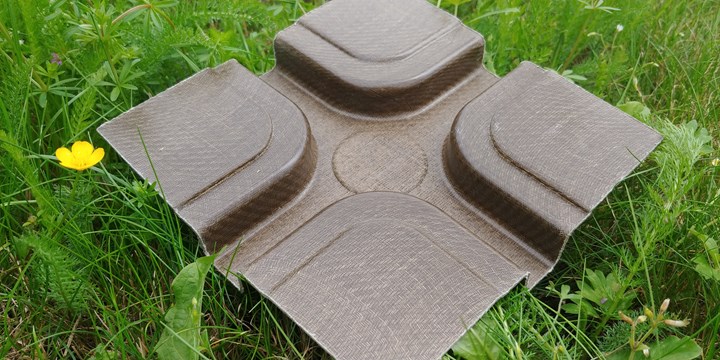Continuous-Fiber-Reinforced Thermoplastic Composite Made Entirely from Natural Resources
Lanxess’ latest addition to the Tepex product line combines fabrics made from flax fibers and a PLA matrix.
A thermoplastic composite made entirely from natural resources is the latest addition to the Tepex continuous-fiber-reinforced thermoplastic composite product line from Lanxess. The new product combines fabric made from flax fibers with PLA as a matrix material. According to the head of Tepex R&D Stefan Seidel, Lanxess is now able to produce this Tepex biocomposite to a level of quality suitable for large-scale production.

Because flax fibers have a significantly lower density than glass fibers, resulting composites are noticeably lighter in weight than their glass-fiber-reinforced counterparts. The flax fibers are used in the form of continuous-fiber reinforced fabrics. This enables the biocomposites to demonstrate the outstanding mechanical performance typical of Tepex, which is based chiefly on the continuous fibers arranged in particular directions. The weight-specific stiffness of the biocomposite is comparable to that of the equivalent glass-fiber-reinforced material variants. Designing the composite components to suit the expected loads enables most of the force to be transferred via the continuous fibers. According to eidel, “This ensures that the high strength and stiffness characteristic of fiber-reinforced plastics are achieved.”
When coupled with transparent matrix plastics such as PLA, the reinforcing flax fabric yields surfaces with a brown natural carbon-fiber look. “This appearance highlights the natural origin of the fibers and the entire composite and creates added visual appeal in sporting goods, for example,” explained Seidel. In addition to sports equipment, the new biocomposite could be used in cars, such as for manufacturing interior parts, or in electronics for the production of such things as housing components.
Like the variants of Tepex based solely on fossil raw materials, the new biocomposites can be completely recycled as purely thermoplastic systems as part of closed-loop material cycles. Said Seidel, “Offcuts and production waste can be regranulated and easily injection-molded or extruded, either alone or mixed with unreinforced or short-fiber reinforced compound new materials.”
In the medium term, Lanxess is planning to use other biobased thermoplastics such as nylon 11 and other natural and recycled fibers in the production of Tepex.
Related Content
-
Prices for PE, PS, PVC, PET Trending Flat; PP to Drop
Despite price increase nominations going into second quarter, it appeared there was potential for generally flat pricing with the exception of a major downward correction for PP.
-
Prices Up for All Volume Resins
First quarter was ending up with upward pricing, primarily due to higher feedstock costs and not supply/demand fundamentals.
-
Advanced Biobased Materials Company PlantSwitch Gets Support for Commercialization
With participation from venture investment firm NexPoint Capital, PlantSwitch closes it $8M bridge financing round.




